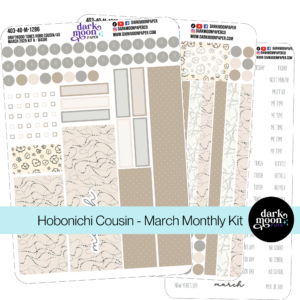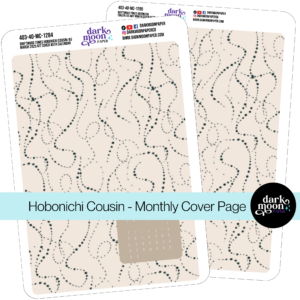Staying organized with ADHD can feel overwhelming, but it doesn’t have to be. ADHD impacts your brain’s executive functions, making tasks like planning, managing time, and staying focused more challenging. The key to ADHD and organization? Work with your brain, not against it. Here’s how:
The goal isn’t perfection. It’s finding a system that works for you while keeping things fun and manageable. Start small, experiment, and build habits that stick.
Finding the right planner can make or break your organizational system. Let’s look at what actually works for ADHD brains.
Pre-formatted planners like Hobonichi Weeks take the guesswork out of organizing your time. Picture this: you open your planner and instantly see your week’s deadlines right next to your daily tasks – no brain gymnastics needed.
"Minimalism is the way to go for an overwhelmed executive-functioning system,"
says Dr. Kimberly Quinn. These planners do the heavy lifting by giving you ready-to-use layouts, so you can focus on what matters: getting things done.

Let’s face it – regular to-do lists can be a snooze fest for ADHD brains.
"Making a task more interesting or enjoyable can fuel creativity and may help people feel more motivated,"
says Dr. Sharon Saline.
Here’s how to jazz up your planning: Try color-coding your tasks (blue for work stuff, green for personal life, red stars for "do this NOW"). Add some quick doodles or mix up your handwriting. These small tweaks regarding ADHD and organization can turn a boring planner into something you’ll actually want to use.
Think of stickers as tiny visual anchors for your ADHD brain. Want to remember that super-important deadline? Slap a bright sticker next to it. Need to track your progress? Checklist stickers show you exactly how far you’ve come.
Pro tip: Pick sticker sets with a theme you love – maybe soft pastels or bold patterns. Just remember: stickers should make your system better, not more complicated. Keep it simple, make it fun, and watch your planning game level up.

Mind maps are a perfect match for ADHD brains. They let you dump your scattered thoughts onto paper and connect them in ways that make sense to you. It’s like creating a road map of your ideas – and since ADHD brains often think in pictures and jump between concepts, this method feels natural.
"For individuals with ADHD, the key to staying organized is to find a system that works for them and stick to it", emphasizes Dr. Sharon Saline, Licensed Clinical Psychologist.
Want to make your mind maps pop? Use different colors for each type of task. Mark research tasks in blue, writing in green, and deadlines in red. This color-coding helps your brain spot and remember information faster. Once you’ve got everything mapped out, you can split these tasks into smaller chunks that don’t feel so scary to tackle.
Here’s a trick that works like magic for ADHD and organization: the Pomodoro Technique. It’s simple – work for 25 minutes, then take a 5-minute break. After four rounds, reward yourself with a 15-minute break. Why does it work? The time limit lights a fire under you to get started (goodbye, procrastination!), while the breaks keep your brain fresh and ready for more.
Think of a bullet journal as your personal command center – it’s got enough structure to keep you on track but enough wiggle room to make it your own. The secret? Start small. Don’t try to copy those fancy Instagram layouts right away. Begin with simple to-do lists, then add features that actually help YOU get things done. Remember: if you try to track every tiny detail, you’ll probably end up tossing the whole system out the window.
Let’s face it – with ADHD, even the best planner won’t help if you forget to use it. Getting started is simple: put your phone to work. Set alarms for times when you’re most alert and ready to plan.
Dr. Regina Lark recommends kicking off each day with a quick 10-minute planning session. Make it stick by linking it to something you already do daily – like sipping your morning coffee. Keep your planner right where you’ll see it, maybe next to your coffee maker or on your nightstand. Want an extra nudge? Apps like Brain Focus or Todoist can ping you throughout the day to help you stick to your schedule.
![]()
The key to actually using your planner? Keep it super simple. Dr. Kimberly Quinn puts it best: when it comes to ADHD and organization, less is more. Skip the long-winded descriptions – stick to quick bullet points and basic checkboxes. Want to add some fun? Dark Moon Paper‘s sticker kits come with ready-made checklists and icons that make planning both easy and eye-catching.
| Time Block | Entry Style | Example |
|---|---|---|
| Morning | 3 Must-Do Tasks | • Pack lunch • Team meeting • Email follow-ups |
| Afternoon | Quick Checkboxes | ☐ Client call ☐ Project draft ☐ Gym |
| Evening | Simple Icons | 📞 Call mom 🛒 Groceries 🌙 Evening routine |
Here’s where the magic happens: take 5 minutes each evening to look back at your day and prep for tomorrow. What worked? What didn’t? Use these quick check-ins to fine-tune your system.
Keep it short and sweet – just glance at what you’ve done, what needs to move to tomorrow, and what’s coming up next. These mini-reviews turn planning from a boring must-do into a helpful daily habit that actually makes your life easier.
Let’s talk about making your planning system truly yours. When you have ADHD, the best organization system blends clear structure with your own flair – think of it as creating your productivity playlist.
Modern planning tools give you lots of options to make them your own. Maybe you’ll click with the clean layout of a Hobonichi Weeks, or perhaps you’ll thrive with the open canvas of a bullet journal. As you use these tools, you’ll figure out what makes your brain happy and productive.
Your perfect setup might mix different approaches – visual mind maps when you need to see the big picture, timed work blocks when you need to focus, and some creative journaling to express yourself. Remember: it’s not about getting everything perfect. It’s about finding what helps YOUR brain work better.
Here’s how you can add your personal touch to different planning elements:
| Planning Part | Make It Yours | Why It Works |
|---|---|---|
| Daily Plans | Add stickers, use colors | Helps you spot and remember things better |
| Tasks | Draw icons, create fun bullets | Makes information easier to understand |
| Time Blocks | Add borders, use washi tape | Shows clear start/end points for activities |
Start with baby steps and try different things. When your planning system feels like "you" instead of something you’re forced to do, staying focused and getting things done becomes part of your natural flow.
Let’s tackle some common questions about ADHD-friendly planning.
Yes! Bullet journals work well for people with ADHD. Here’s what Dr. Sharon Saline, Licensed Clinical Psychologist, has to say:
"Bullet journaling and its rapid logging offers a quick place to externalize any thoughts you want to ‘keep’ throughout the day."
The beauty of bullet journals? You can quickly jot down your racing thoughts without getting stuck in a rigid system.
Keep it simple!
Your planner needs just three main parts:
| What You Need | Why It Helps | How to Use It |
|---|---|---|
| Calendar | Keeps track of what’s coming up | Add colors to make events pop |
| Daily Schedule | Shows how to use your time | Leave room to write notes |
| Goal Space | Helps you stay on track | Break big goals into small steps |
While apps like Evernote and Todoist can help, old-school pen and paper might be your best bet. Writing things down by hand helps you remember them better.
New to planning? Try the Hobonichi Weeks – it comes with built-in organization. Want more freedom? A bullet journal lets you create your own setup. The best system is the one you’ll actually use, so pick what feels right for you.
Stickers Made for Planning
Our custom stickers are a fuss-free way to brighten up your planner pages with perfectly-sized designs that add a spark of personality to every layout.

Why use planner stickers?
Planner stickers make organizing easy, fun, and personal! Add color, creativity, and structure to every page, transforming your planner into a tool that reflects you. Perfect for tracking, decorating, and staying inspired daily!







Hello and welcome!
I’m Rachael Snow, a lifelong artist and entrepreneur, and I started Dark Moon Paper to blend my love of art, technology, and the mysterious beauty of the world around us. My sticker kits are meant to set the mood, tell a story, and give you a little escape from the ordinary.
I work from my cozy studio tucked away in the beautiful woods of Oregon, surrounded by nature and a dark night sky full of stars.